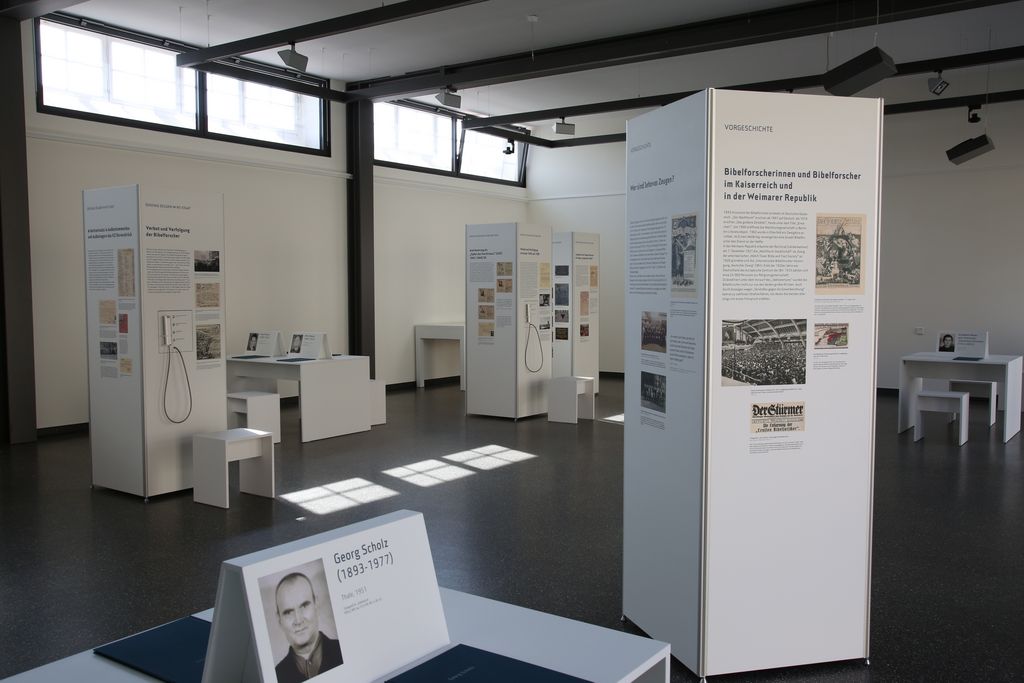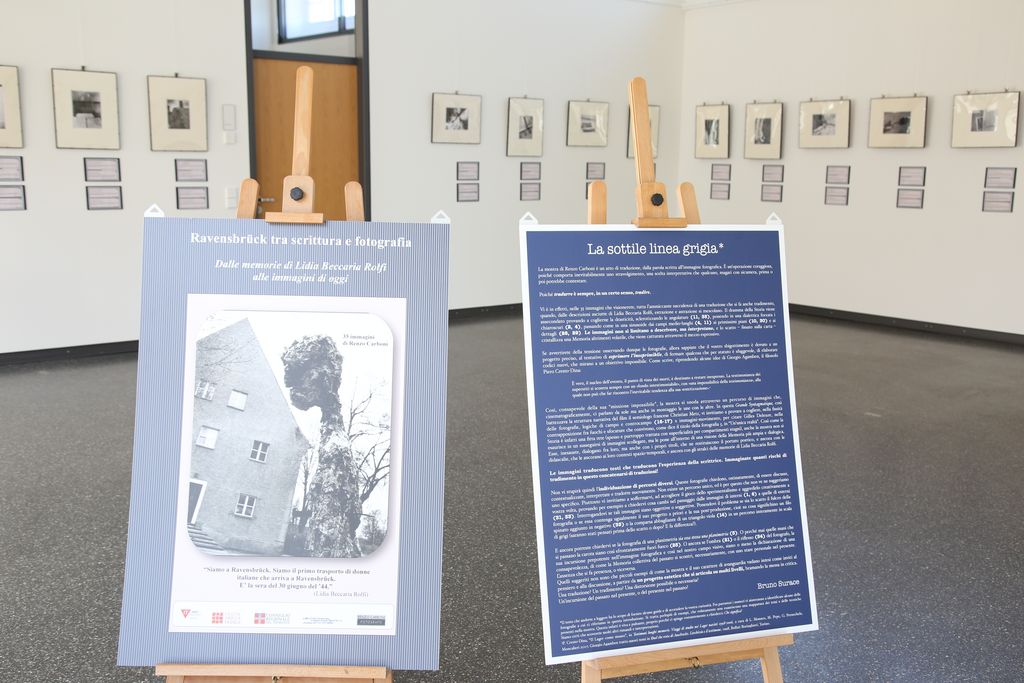Previous exhibitions
1940-1945 Krieg und deutsche Besatzung im Norden und im Westen
Die Ausstellung der Ständigen Konferenz der NS-Gedenkorte im Berliner Raum widmet sich auf zehn Tafeln den Geschehnissen in Norwegen, Dänemark, Belgien, Luxemburg, den Niederlanden, Frankreich und Großbritannien sowie der damit verbundenen Erinnerungskultur.
‘The Opposite Shore’: Ravensbrück and Fürstenberg
This exhibition displays prints created by students from Berlin’s Ernst Litfass School of Media Technology and Design as part of a one-week project entitled ‘Ravensdruck’ (meaning ‘Ravensbrück prints’). Funded by the Dr. Hildegard Hansche Foundation and Ravensbrück’s International Friends Association, the Ravensdruck project has now been hosted at the Memorial for the seventh time. During an introductory event with historian Annette Leo, the nine participants learned about the relationship between Ravensbrück Concentration Camp and the town of Fürstenberg. In the camp’s former gatehouse, they then created prints about what they had learned and experienced, which are now presented in the exhibition. The Ravensbrück Memorial Museum would like to thank the students of the Ernst Litfass School and their printmaking teacher Ingo Grollmus.
‘Antisocial’: A Look at Exclusion from Yesterday to Today
This exhibition from the Institute for Conflict Research offers a focussed overview of the persecution of girls and women who were labelled ‘antisocial’, examining the terminology, dominant characterizations, legal frameworks, and official structures, as well as the conditions of concentration camp imprisonment.
Learn more
Women of the Resistance: German Political Prisoners at the Ravensbrück Women’s Concentration Camp, and Their Lives Before and After 1945
This exhibition highlights the biographies of German political prisoners at the Ravensbrück women’s concentration camp. Beginning with the formative years under the Weimar Republic, their life stories are traced through the years of persecution and resistance after 1933 and into the prisons and camps of the Nazi regime. The focus then turns to their later political activities in East and West Germany after 1949, up into the 1990s.
Learn More
‘Racial Diagnosis: Gypsy’: The Genocide of the Sinti and Roma and the Long Struggle for Recognition
Prepared by the Documentation and Cultural Centre of German Sinti and Roma, this exhibition looks at the ostracism and disenfranchisement of the Sinti and Roma minority in Germany up to its systematic annihilation across Nazi-occupied Europe. It also examines the post-war German history of the survivors, who were not formally recognized as victims of Nazi persecution for many years. Arrested as ‘gypsies’, some 2,800 Roma and Sinti were imprisoned at Ravensbrück.
Learn more
Objects from the concentration camps
This exhibition presents ten large-format photographs of objects from the Ravensbrück women’s concentration camp, images taken by Richard Wiesel in 2018. The photographer’s aim is to tell the story behind the artefacts. Exhibited in Sydney in 2018, the photos are now being shown in Germany for the first time.
Children in the Bergen-Belsen Concentration Camp
Children in the Bergen-Belsen Concentration Camp is a special exhibition examining the specific conditions and coping behaviours of these interned children. Using topical and biographical approaches, the exhibition presents multiple perspectives based on a wide range of pictorial and textual sources ranging from contemporary diaries, drawings, and photos, to retrospective personal accounts as well as audiovisual recordings made shortly after liberation. More than 4,300 women and children were deported from Ravensbrück to Bergen-Belsen, including Ivan Lefkovits and Ceija Stojka, who are portrayed in the exhibition.
An exhibition from the Bergen-Belsen Memorial, funded by the Klosterkammer Hannover and Germany’s Federal Government Commissioner for Culture and the Media
The exhibition was on view at the Ravensbrück Memorial Museum from 13 October 2018 to 31 March 2019.
Verboten und verfolgt. Jehovas Zeug*innen im KZ Ravensbrück und in Haftanstalten der DDR
Die Ausstellung widmet sich Jehovas Zeug*innen, die im NS-Staat unter anderem im Konzentrationslager Ravensbrück inhaftiert und später in der DDR erneut verfolgt waren. Zeug*innen Jehovas hielten sich an die Worte des Propheten Daniel (Daniel 3,17f.) und flüchteten nicht aus der Haft. Sie betrachteten diese als eine Prüfung nach Jehovas Willen und wurden deshalb von der SS in SS- und Privathaushalten und auf landwirtschaftlichen Gütern ohne Bewachung eingesetzt.
Ravensbrück between Writing and Photography: From the Memories of Lidia Beccaria Rolfi to Images of Today, Renzo Carboni
35 photographs by Renzo Carboni
About his exhibition, the photographer writes: ‘The book Le donne di Ravensbrück [“The women of Ravensbrück”] gave me an opportunity to translate several passages into photographs, and, as if they were part of a film script, I let myself be guided by the texts themselves in the transition from written word to visual memory. The images thus represent a new kind of narration, one that takes up the traces of the past in an interpretive way, thereby carrying forward the memory of what was once the world of the camps.’ Renzo Carboni, photographer, Turin, 21 November 2017
An exhibition by the Ravensbrück Memorial Museum in cooperation with Ravensbrück’s International Friends Association (IFK e.V.)
The exhibition was on view from 11 March to 9 April 2018 at the Ravensbrück Memorial Museum.
Hamburg’s Curiohaus Trials: Nazi War Crimes before British Military Tribunals
The punishment of those responsible for Nazi atrocities was an important priority for Germany’s Allied occupiers. The Nuremberg Trial of major war criminals attracted worldwide attention and is considered a milestone in legal history. What is less well known is that the Allies carried out hundreds of other trials, including trials against SS personnel from Ravensbrück. This exhibition offers new and surprising insights into the broader spectrum of Nazi crimes and their repercussions in post-war German society.
An exhibition from the Neuengamme Concentration Camp Memorial with the support of the Hamburg Parliament.
The exhibition was on view at the Ravensbrück Memorial Museum from 7 October 2017 to 31 January 2018.
From the Collections: Portraits of Former Inmates, an Exhibition with Paintings by Christoph Wetzel
These thirteen paintings by Christoph Wetzel are a special component of the collections held by the Ravensbrück Memorial Museum: the individuals portrayed are survivors of the women’s concentration camp who later devoted themselves to preserving the memory of Ravensbrück in various ways. Commissioned by the Memorial, Christoph Wetzel painted the women’s portraits from 1991 to 2008.
Learn more
But I live. Three Stories of Child Survivors of the Holocaust.
Emmie Arbel survived the Ravensbrück and Bergen-Belsen concentration camps as a little girl. David Schaffer escaped the genocide in Transnistria because he did not abide by the rules . Brothers Nico and Rolf Kamp, separated from their parents, were hidden from their murderers in thirteen different sites by the Dutch Resistance. Only a few Holocaust survivors are still alive today. Recording their memories is crucial. But I live undertakes this task in exceptional ways: It creates graphic histories for which there are scarcely any documentary models. Working closely with the four survivors, the internationally renowned artists—Miriam Libicki (Vancouver, Canada), Gilad Seliktar (Pardes Hanna-Karkur, Israel), and Barbara Yelin (Munich, Germany)—produced graphic reconstructions of the survivors’ memories.
These (hi)stories directly and movingly visualize incomprehensible events. In so doing they create a new memory-archive for future generations. The medium of graphic storytelling (“comics”) thereby proves itself to be a powerful means—beyond that of photorealistic representation—of plausibly, subjectively, and as truthfully as possible reconstructing in narrative form what was visually undocumented. Using original drawings, sketches, archival materials, and interviews with participants, the exhibition illuminates the process by which the book came into existence.
10. Ravensdruck »EMMIE TO EMMIE«
The ‘Ravensdruck’ project workshop took place for the 10th time at the Ravensbrück Memorial from 9 to 13 October 2023. The exhibition ‘EMMIE TO EMMIE’ was opened on Friday, 13 October 2023.
was opened, showing prints by nine pupils from the Ernst-Litfaß-Schule in Berlin Wittenau, who spent a week visiting the memorial and not only had the opportunity to engage intensively with the history of the site, but also to meet contemporary witness Emmie Arbel, who survived the Ravensbrück concentration camp as a child.
Learn More
Zofia Pociłowska-Kann (1920 – 2019) Sculptures
Faces from the Past - Breasts of the Earth - Behind these titles are sculptures by the sculptor Zofia Pociłowska. She was imprisoned in Ravensbrück concentration camp from 1941-1945 and became a sculptor after the war. From 18 April we will be showing sculptures in an outdoor exhibition. Many of them are being shown in Germany for the first time.
We would like to thank the daughters of Zofia Pociłowksa, Aleksandra Kann-Bogomilska and Agnieszka Kann, for their willingness to lend the sculptures and their support of the exhibition.
An exhibition of the Ravensbrück Memorial/Stiftung Brandenburgische Gedenkstätten in cooperation with the Institute for the History of Art and Images, Chair of Art History of Eastern Europe at the Humboldt University in Berlin.
The exhibition was made possible thanks to the financial support of the Federal Government Commissioner for Culture and the Media in the context of the 76th anniversary of the liberation of the Ravensbrück concentration camp.










![[Translate to English:] Der Maler Christoph Wetzel porträtiert Aat Breur, 2000 [Translate to English:] Der Maler Christoph Wetzel porträtiert Aat Breur](/fileadmin/_processed_/1/5/csm_Wetzel_malt_Breur_20097c99e2.jpg)



